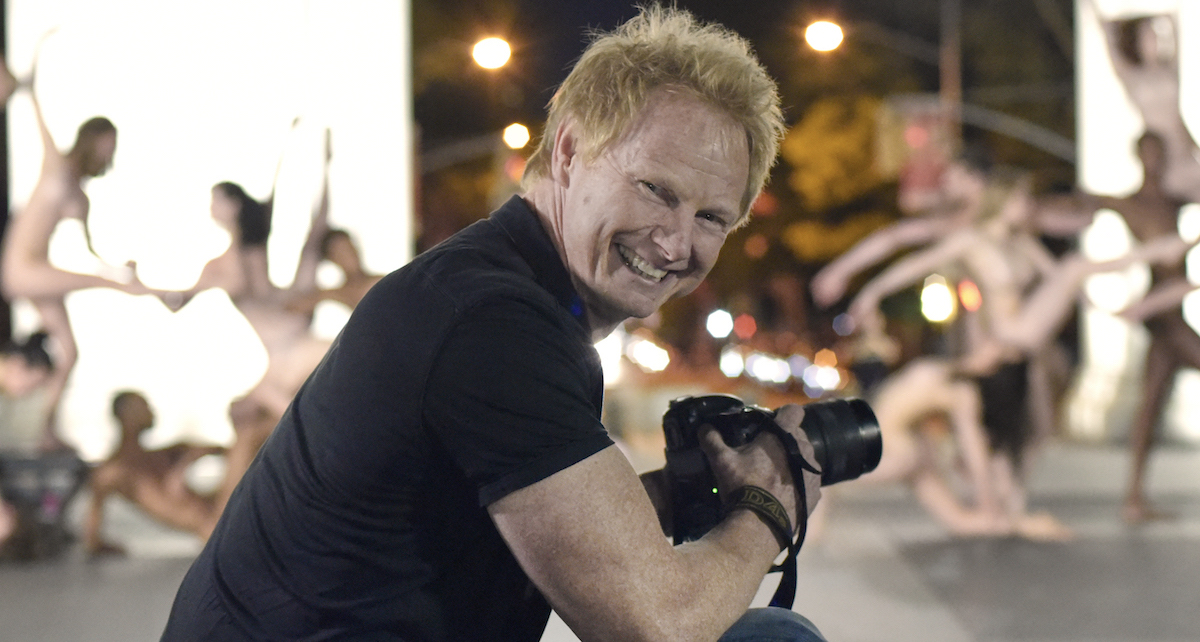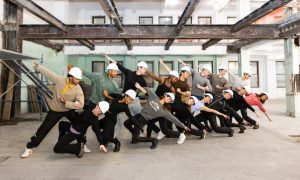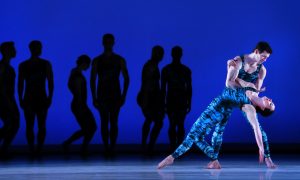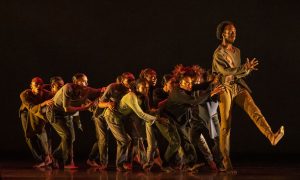Actor-turned-photographer Jordan Matter became recognized in the dance community with his 2012 New York Times bestselling book, Dancers Among Us: A Celebration of Joy in the Everyday. The photography book stars dancers (from some of the world’s elite companies and productions) leaping, spinning, partnering and posing in everyday scenes: local parks, sidewalks, restaurants and subway stops. Thanks much to Dancers Among Us and the growth of photo-sharing social media apps such as Instagram and Pinterest, dance photography has exploded into an exciting and beautiful genre of photography.
Now, four years later, Matter is publishing a second book of dance photography entitled Dancers After Dark. The highly anticipated “sequel” features images of nude dancers posing at nighttime in different public outdoor scenes across both the United States and Europe. The images are so breathtaking in composition and creativity that one would think the dancers posed in front of a green screen in a perfectly lit private studio. But that was not at all the case. Dance Informa got the inside scoop on Matter’s adventure shooting Dancers After Dark, to be released on October 18.
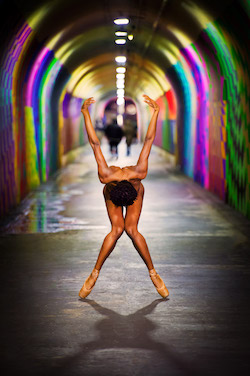
‘Dancers After Dark’. Photo by Jordan Matter.
What inspired you to begin photographing dancers?
“I had no experience in dance photography (or dance, for that matter). A few years back, I was asked to take portraits of the Paul Taylor company dancers. That same night, I was watching my son play with his toy bus, and he had this level of enthusiasm that was just magical. I realized that as we get older, we lose this sense of magic in our everyday lives. Because dance was already on my mind, I wondered if I could photograph dancers to remind us of those magical moments. It worked out well because I was able to reach out to the Paul Taylor dancers to begin the project. This became Dancers Among Us.”
Do you have a dance background yourself?
“I’ve come to learn a lot about dance now, but I didn’t have any prior dance knowledge or experience. I had been an athlete in college, and the athleticism of dance immediately connected with me and intrigued me. I identified with it in terms of the repetitive training, strength and agility that are required. When I started photographing dance, I began to learn about the subtlety and nuance that bring out the artistry and storytelling. And as my work progressed, it became much less about the ‘wow’ moments (big jumps and tricks) and more about the intimacy of dance.”
What makes dance photography unique?
“Dance photography has become a phenomenon over the past several years. You even see a lot of dancers featured in fashion nowadays. Dancers Among Us came out four years ago when Instagram was relatively new. Nobody was really doing dance photography. But now — thanks a lot to social media — it’s exploded.
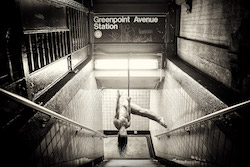
‘Dancers After Dark’. Photo by Jordan Matter.
Dancers have this fearlessness, beauty and enthusiasm that come together to create some really exciting opportunities for photography. You’ve also got their strength and flexibility, and also their ability to tell a story or capture an emotion through their body language and movement. What I love most about dancers is their sense of adventure and willingness to try absolutely anything. My work is often volunteer-based; the dancers are excited and choose to be a part of it. Furthermore, dancers are notoriously self-critical. That’s actually good for photography because they don’t stop until they achieve the perfect shot.”
Because dance is a moving, fluid art form, is it a challenge to capture dance in a still photograph?
“It’s definitely a challenge, but a thrilling one. It’s challenging to capture movement, and then my goal is to capture movement within the context of everyday life. The composition of pedestrians, natural light, weather, danger and legality can all change within a minute. You can attempt to photograph the perfect arabesque in a studio with the proper lighting, flooring and all of that. It’s quite another thing to try and photograph the perfect arabesque in the middle of a Times Square crosswalk at rush hour!”
What makes a ‘good dance shot’?
“Something that surprises me! There is now so much dance photography that it all tends to blend together. You see a lot of the same thing over and over again. I think a good dance shot is something that’s unique to that moment and can never be captured the same way again. You can photograph the perfect leap or arabesque, but what’s exciting is presenting it in a way we haven’t seen before.”
How did Dancers After Dark come about?
“Dancers Among Us was published in 2012 (though I had been working on it for several years prior) and became both a New York Times and international bestseller. With the growth of Instagram and photo sharing on social media, I soon began to see my work ‘grabbed’ and posted without credit or imitated to the point of plagiarism. I even began to see that I was copying myself a bit. I needed to be re-inspired.
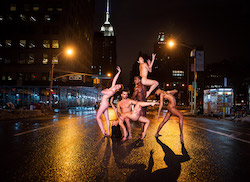
‘Dancers After Dark’. Photo by Jordan Matter.
I once again longed for the thrill of something that’s never been seen before. That’s how Dancers After Dark came about. I spent two (exhaustive) years photographing hundreds of dancers in cities all over the world — at night and nude! The work celebrates dance and the dancers’ commitment to their craft while also pushing the boundaries in dance photography, which has become over-saturated with the same kind of images.”
Photographing naked dancers in public wasn’t exactly legal. How did you skirt the law?
“I definitely didn’t pursue public nudity in Dancers After Dark because it was illegal, but it certainly added to the thrill of the project! We had to shoot very quickly both because of the illegality of the situation and also, of course, the vulnerability of the naked dancers. This is how it would go down. First of all, we would arrive to the location with absolutely no plan. Sometimes, I would just post on Facebook that I was near a Barnes and Noble or an historical landmark and ask volunteer dancers to meet me there for the shoot. Together, we would figure out a pose and practice it a few times while the dancers were still clothed.
That’s one of the things I really loved about this project — the synergy between photographer and dancers. They were instrumental in creating the images. Also, the people who were photographed together often didn’t know each other! So the dancers would meet, collaborate and work together on the spot. You hear so much about the cutthroat competition of the dance world, but this book really celebrates the collaboration and support of the dance community. When a dancer wasn’t being photographed, he or she was right next to me throwing out notes and suggestions to the dancer I was shooting. They weren’t thinking, ‘I want my picture to be better.’ They were shouting, ‘Point your foot! Arch your back!’ and other constructive cues.
After the clothed dancers practiced the shot a couple of times, they quickly stripped and reenacted the pose once more (maybe not for more than 20 or 30 seconds at most). The adrenaline rush was incredible! And what’s spectacular is that you look at the final image, and it’s so calm and effortless — a true testament to the dancers’ ability to perform under pressure.
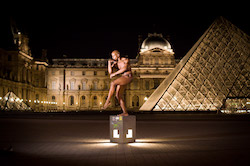
‘Dancers After Dark’. Photo by Jordan Matter.
One great story is when I shot a male Alvin Ailey dancer at the Louvre in Paris. We decided on the ‘thinker’ pose, which, in the book, looks so calm and cool. But what really happened was that once we figured out the image we wanted, the dancer strips, we jump the fence, another dancer next to me is holding a light and screaming out notes, a security guard starts screaming at me in French, and I frantically scream back at him…but keep shooting! This maybe all happened in, like, 25 seconds. And then all three of us immediately sprint three blocks away to escape the security guard. But looking at the final photo, you would never sense the kind of chaos that transpired during the shoot.”*
*Matter includes many of these anecdotal photo shoot stories in an addendum at the end of the book.
What were the challenges of shooting Dancers After Dark? How was it similar or different to shooting Dancers Among Us?
“There was always urgency, either because of the public nature of the shoot or the quality of the light or the circumstances of the location. It was rarely relaxed like a typical photo shoot.
I could not have done this project without having done Dancers Among Us first. Dancers Among Us gave me the credibility and trust that were absolutely integral to Dancers After Dark due to the safety and vulnerability of dancers posing nude and in public.”
What are you working on now?
“This is the best work I think I might ever do. The experience — the romance and thrill of traveling around Europe and North America and getting to work with the most fearless, talented dancers — was so incredible that everything else will be sort of a let down in comparison.
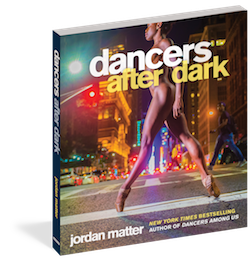 But I am still working on new ideas! Right now, I’m shooting a new project called Tiny Dancers Among Us, which is basically just like Dancers Among Us but with kids. It’s childhood as seen through dance, and the images really convey the sense of enthusiasm and ‘living in the moment’ that is so magical about childhood and that we need to remember in our adult lives.”
But I am still working on new ideas! Right now, I’m shooting a new project called Tiny Dancers Among Us, which is basically just like Dancers Among Us but with kids. It’s childhood as seen through dance, and the images really convey the sense of enthusiasm and ‘living in the moment’ that is so magical about childhood and that we need to remember in our adult lives.”
For more information about Jordan Matter and his photography, and to purchase Dancers Among Us, Dancers After Dark and Matter’s other photography books, visit www.jordanmatter.com.
By Mary Callahan of Dance Informa.
Photo (top): Jordan Matter. Photo by Charlie Naebeck.


